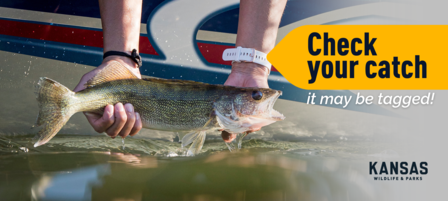Fish Telemetry Project Underway at Tuttle Creek and Milford Reservoirs

For Immediate Release:
May 17, 2023
Contact:
Nadia Marji CMP®, Chief of Public Affairs
nadia.marji@ks.gov
Fish Telemetry Project Underway at Tuttle Creek and Milford Reservoirs
EMPORIA – The Kansas Department of Wildlife and Parks is partnering with Kansas State University on a long-term telemetry study to examine movement patterns and space use of Kansas’ most recreationally valuable fish. Data collected during this study will give Fisheries biologists a better understanding of fish movement within reservoirs and fish passage downstream through reservoir dams.
Biologists will be implanting 15 acoustic transmitters in the following species at Tuttle Creek and Milford reservoirs:
- Blue catfish
- Channel catfish
- Walleye
- Saugeye
These transmitters will allow biologists to monitor fish movement over the next several years. Fish fitted with the acoustic transmitters will be externally marked with a small purple vinyl tag affixed just below the dorsal fin. Each tag is labeled with “KSU RESEARCH – PLEASE RELEASE” on one side and a tag ID number with contact information on the other. Because of the limited number of tagged fish, it is imperative that anglers release all fish affixed with the purple tag. Since external tags can sometimes dislodge, anglers are also encouraged to thoroughly examine captured fish for a small 1- to 2-inch incision scar, possibly with sutures, near the pectoral fins.
In addition to transmitters, underwater receivers will also be utilized and have been placed in Tuttle Creek and Milford reservoirs, as well as the Republican, Big Blue, Kansas, and Smoky Hill rivers. Receivers are placed on mooring lines marked by yellow or orange bullet floats with white stickers labeled “FISH RESEARCH EQUIPMENT – DO NOT DISTURB.” These receivers are deep underwater and continuously “listen” for telemetered fish, allowing biologists to know when a specific fish was near each receiver.
This collaborative effort with KSU complements earlier blue catfish tagging studies conducted by KDWP in Tuttle Creek and Milford reservoirs. Fish tagged in the earlier studies are marked with an orange or yellow tag and do not have implanted transmitters; these fish may be harvested if they meet the legal length requirements.
Data collected from tagged fish is crucial for biologists to manage fisheries and assist in future angling success. Anglers should report the catch and release date, and location, of fish with purple tags to kgido@ksu.edu. If a blue catfish with an orange or yellow tag is caught, please instead call (620) 342-0658 to report the catch.
###









